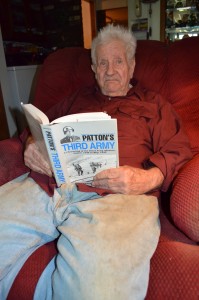WESTFIELD-For Jay Yaple, 72 years seems like yesterday when he recalls the day he was captured by the Germans during the Battle of the Falaise Pocket, two months after D-Day.
Yaple, now 90, is among the 855,000 veterans remaining of the 16 million who served our country during World War II.
For Yaple, the wounds he suffered on Aug. 16, 1944 at the hands of the Germans are still a vivid part of his memory.
“I was a private in Company A, 359th Infantry Regiment, Third Army,” said Yaple in his home on Francis Street, as a copy of Patton’s Third Army sat on a table next to his easy chair. He had joined the U.S. Army on Nov. 12, 1943.

Jay Yaple of Westfield, a World War II vet who was captured during the Battle of the Falaise Pocket, enjoys the solitude of his indoor garden pond complete with koi.
“On Aug. 16, our lieutenant sent four of us in the squad to go into town to help tighten up the Falaise Gap,” he said.
The Battle of the Falaise Gap, also referred to as the Battle of the Falaise Pocket, was the decisive engagement of the Battle of Normandy during World War II, according to Wikipedia resources. A pocket had been formed around Falaise where the German Army Group B, with the 7th Army and the Fifth Panzer Army, were encircled by the Western Allies. The Falaise Gap was a corridor which the Germans struggled to maintain which would allow their escape. From Aug. 12-21, the battle resulted in the destruction of most of Army Group B west of the Seine River, which opened the way to Paris and the German border for the Allied armies, according to Wikipedia.
After the closing of the gap, General Dwight David Eisenhower had recorded that “The battlefield at Falaise was unquestionably one of the greatest killing fields of any of the war areas. Forty-eight hours after the closing of the gap, I was traversing through it on foot, to encounter scenes that could be described only by Dante. It was literally possible to walk for hundreds of yards at a time, stepping on nothing but dead and decaying flesh.”
Yaple has a vivid account of his time on the Falaise Gap battlefield.
“I had my M-1 rifle and after walking into the town I saw a German soldier who threw a grenade at me,” said Yaple, noting he then had shrapnel in his right foot. “I was able to fire one round and then recessed into an alleyway, and as I pivoted on my foot, a second grenade went off which caused shrapnel to penetrate my left leg.”
Yaple said he “hollered out” he needed a medic since he had been hit.
“I heard a voice say ‘Can you walk? Go to the command post,’” said Yaple.
Yaple said as he was contemplating his situation German soldiers approached him and he soon found himself sitting in a house with one soldier about 15 years of age who was tracking the situation from a window and another soldier who created a commanding presence in the room.

Jay Yaple of Westfield has vivid memories of the day he was captured by the Germans in World War II. He is seen in his home with one of his favorite books.
“One of the German soldiers was a big guy, about six feet tall, and had an automatic weapon on his right hip,” said Yaple. “I thought he was going to kill me.”
Yaple added he was resigned to his fate.
“I didn’t mind dying,” he said, adding “I just didn’t want to hear the gun go off. When you get into a situation like that, you nullify it or get out of it.”
What seemed like an eternity lasted only a few hours since Yaple says he woke up in a field hospital run by the Americans.
“I don’t know how I got there,” he said. “When I woke up I was surrounded by wounded German soldiers. At first the Americans questioned who I was.”
After a fingerprint test confirmed Yaple’s story, he was “patched up” and flown to England on a C-47 transport plane to recuperate.
“I was one of the first patients to be flown out of France,” he said.
Yaple said while he was in the hospital in England his brother Harold walked in on him.
“Harold served in the 8th Air Force,” said Yaple. “My brother said, ‘you better write home,’ because our parents had received a letter from the U.S. Army said that I had been seriously injured.”
Yaple said he called his mother as soon as he was able to and assured her he was fine.
“I told my mom I got scratched,” he said.
While he was recuperating, he said his therapy required him to start walking.
“I was starting to walk but my right foot was killing me,” he said. “Officials at first did not believe I was injured and took X-rays to confirm that I had three pieces of steel in the arch of my foot, as well as shrapnel in my left leg.”
He eventually arrived “stateside” and served in a non-combative role during his continued recuperation and tour of duty.
Since the shrapnel pieces were in areas that physicians were not comfortable operating on, Yaple said he has lived all these years with the wounds of war inside his body.
“My leg and foot still bother me,” he said, adding his legs still swell up periodically.
By V-E Day (Victory in Europe Day) on May 8, 1945, which signaled the end of World War II in Europe, Yaple said he was told “we don’t need you now” and he was honorably discharged May 20, 1945.
Wikipedia notes that the Falaise battle claimed at least 15,000 German lives as well as nearly all of their vehicles, guns, and tanks. Also, another 50,000 men surrendered or were captured, adding to Germany’s total of 400,000 men killed or captured since D-Day. The Allies had also paid a price for their victory – since D-Day, 209,703 Allied soldiers had been killed, wounded, or captured – 125,847 were Americans.
For Yaple, a native of Woodridge, N.Y., he settled in Westfield and worked as a finishing carpenter for many years, as well as for the former Stevens Paper Company as a slitting machine operator. He proposed to his first wife, Helen Hildack, on a “little bridge on Lockhouse Road,” and they raised three girls and one boy. Helen Yaple passed away due to cancer and in later years he would marry Grace Shay and the couple had a daughter.
For the past 15 years, Yaple has had the delightful company of Pat Broderick of West Springfield, and both enjoy long drives in the countryside and making dinners together.
“I’m still very active,” said Yaple, adding a lot of his time is spent gardening as well as tending to an indoor koi pond that is surrounded by lush vegetation.
As Yaple soon celebrates his 91st birthday in early September, he still thinks about those war days more than 70 years ago.
Yaple tears up and says, “I’ve often wondered what happened to that 15-year-old boy who I had been held hostage by.”


